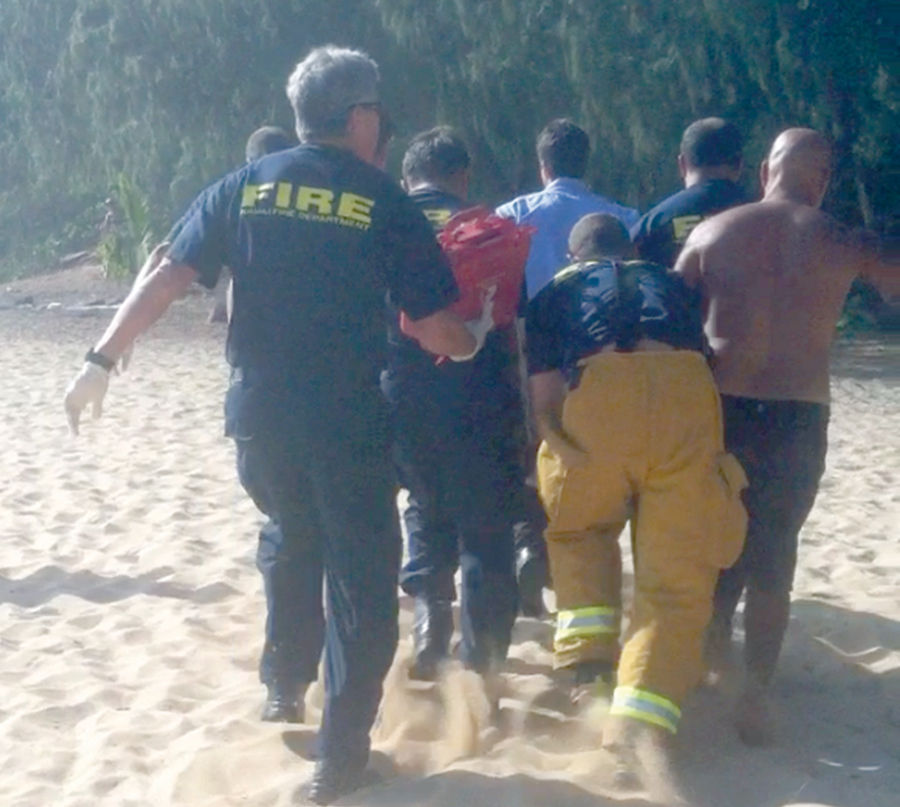LIHUE — A Colorado visitor drowned Tuesday at Keoneloa Bay, also known as Shipwreck’s Beach, in Poipu — Kauai’s fourth visitor drowning of the year and the third in the last four days.
Jake Jelinek, 74, died around 4 p.m.
County officials said Jelinek appeared to have hit his head on a reef after he had difficulty swimming in large waves. He was first noticed floating face down in the water and family members then swam out to him. With the help of bystanders, they brought the victim to shore and performed CPR until fire personnel arrived but efforts to resuscitate were unsuccessful.
He was transported by medics to Wilcox Memorial Hospital, where he was pronounced dead.
“My friend and I were sitting at the beach when there were locals swimming about 25 yards off shore,” Waimea resident Cheri Kua, who witnessed the incident, told The Garden Island on Wednesday. “They pulled an elderly male on shore but the surf was so high yesterday. They were doing CPR but the water was washing on shore so they carried him higher so the water wouldn’t get him and they did CPR again and the paramedics finally came.”
Kua said Jelinek was bleeding by the time he was back on shore.
“My friend was actually trying to stop the bleeding by holding a towel to his head,” Kua said “He was unconscious and he didn’t have a pulse at all when he landed on shore.”
Kua said it was a difficult scene to observe.
“It was tragic,” she said.
It marks the third visitor drowning since the weekend. On Saturday, 72-year-old Michael Stone of Boston drowned in waters off Plantation Hale in Wailua. On Sunday, David Deville, 48, of Arizona died while snorkeling off Mahaulepu Beach.
Kauai has been battling to keep its visitors safe. Sixteen people drowned in 2013, all at unguarded beaches, which can appear safe and calm, but can be dangerous with rip currents that can pull swimmers out and large waves that can suddenly roll in and sweep swimmers out to deep waters. Six people drowned in 2014.
Island officials and organizations have taken steps to prevent drownings. The Kauai Visitors Bureau and Kapaa Rotary Club worked on a short video that plays continuously at the Lihue Airport and warns guests about the dangers of the ocean and how to remain safe. Kauai has 10 beaches protected by 48 lifeguards. There are more than 200 rescues tubes posted on beaches around the island, which people can use to pull victims to shore.
“The lifeguards themselves do a huge job,” said Monty Downs, president of the Kauai Lifeguard Association. “They’re at the beaches everyday. Because we know people are going to go to non-lifeguarded beaches, we’ve worked very hard to put rescue tubes in beaches around the island at some attempt to have some safety devices there.”
Downs also understands the heartache experienced by families who have lost a loved one to drowning.
“It’s very sad,” Downs said. “You can just go with numbers, only four drownings here, but as an E.R. doctor, I know what each drowning is: Each drowning is a family that is acutely devastated.”
Some tourists on island said they try and stay atop conditions to avoid perilous situations.
“We always make sure that we’re together and we make sure where everybody is,” Oregon resident Wendy Jones said Wednesday. “We actually have headbands on the back of our snorkel gear so that they’re brightly colored so that you can see everyone.”
Jones’ husband, Jeff, also stated that they check local surf conditions before heading out.
“A lot of times we’ll stop at the dive shops, ask what the conditions are,” Jeff Jones said. “If there’s a lifeguard on one of the beaches, we’ll stop and talk to them.”
Wendy Jones’ parents, Donna and Forrest Young, have visited Kauai for 15 years, and have also educated themselves about the ocean’s waves.
“I always make sure I have all of my safety gear, my life vest, and my life preservers,” Forrest Young said. “I boat quite a bit and I make sure everything’s up to snuff. If there’s one thing I’ve learned, it’s never turn your back on the ocean.”
KLA Vice President Jim Jung said the organization also distributes brochures that inform visitors and locals about the dangers of the ocean, explains what a riptide is and what to do if caught in one.
These brochures are found at many hotels across the island and placed at airport racks by the County of Kauai’s Office of Economic Development.
“We put up beach signs that tell where the riptides are with arrows,” Jung said, adding they also promote a keiki lifeguard program to train young rescuers as well as make W.A.V.E — water awareness visitor education — presentations at the hotels around the island to get the word out on the danger Kauai waters pose.
Despite these precautions, Jung said people can still be oblivious to beach hazards.
“Folks are unaware of the dangers of walking on rocks and being washed away by a wave,” Jung said. “They’re unaware of shore and reef breaks where they can be held under longer than they can hold their breath. Some folks will panic and hyperventilate and involuntarily swallow water.”
In 2013, Kauai’s lifeguards made 472 rescues, according to Jung.
“Imagine if they weren’t around,” Jung said. “That’s why we advise people to swim near a lifeguard because they’re knowledgable and skilled and can provide assistance.”
Sue Kanoho, KVB executive director, said the organization also relies on education to prevent drownings on Kauai.
Its mantras are “if in doubt, don’t go out” and “know before you go.”




